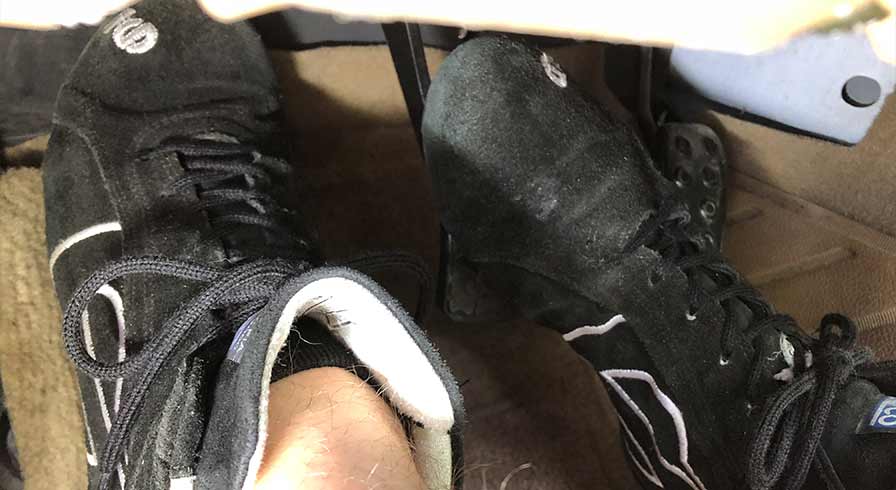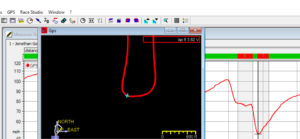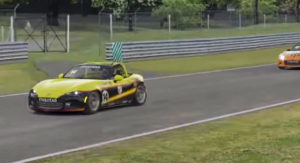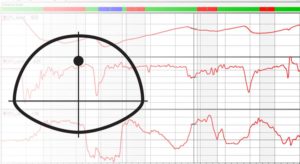The Purpose of Downshifting
Let’s start with this question. What is the purpose of downshifting? Downshifting is necessary in order to put the car in the optimal gear to maximize acceleration when the time comes to squeeze on the throttle after we have exited a corner.
Contrary to popular belief, downshifting shouldn’t be used to slow the car down. That’s what the brakes are for. It is the goal of the performance driver to get the downshifts done in a way that doesn’t affect the balance of the car. Ever seen a car spin out suddenly in the brake zone of a corner? It usually isn’t the result of too much rear brake strength, but rather the result of an uncoordinated downshift. Downshifting shouldn’t ever upset the balance of the car, never mind spin it out.
Depending on the corner type, downshifting may be done before or after turn in. Downshifting ideally occurs somewhere between the brake point and the turn in point. Providing the engine isn’t over revved, the sooner you can get those downshifts done the more you can focus on the release of the brake.
Different Types of Transmissions
In today’s modern era we have many different types of transmissions and therefore many different ways to change gears. We have everything from fully automatic where the car’s computer has exclusive control over gear selection to the old school H pattern gearbox where the driver has ultimate control.
Regardless of how the shift occurs, whether manually or automatically, that shift will have an effect on the traction of the drive wheels. This is something the performance driver needs to be aware of.
Most prefer some type of manual transmission because the driver has full control over gear selection. This is ideal in performance driving because we can maximise the grip of the drive tires by getting the shift done smoothly.
H pattern gear boxes a common favorite. This is where the car has a clutch pedal and any gear can be selected at any time. H pattern transmissions are usually “slower” when it comes to lap time but are way more fun in my opinion!
Sequential gear boxes are another common type of transmission. This is where the driver can go up and down 1 gear at a time with either paddles behind the steering wheel or a gear shift lever in the center console that is pushed back and forth.
“Rev Match” Your Downshifts
Regardless of what type of transmission your car has, let’s go through some fundamentals.
Let’s say you’re driving down the road at 60mph in 4th gear. Your engine speed (RPM) would be a certain number, let’s say 5000 in this case. But what if you were doing the same 60mph but in 3rd gear? Your engine RPM would be higher, let’s just say this number is 5900.
If you were to suddenly put the car in 3rd gear the engine would be forced to rev higher by the momentum of the spinning tires and weight of the car. In addition, the drive tires would also be forced to slow down to equalize the road speed with the engine speed.
You can imagine how this would make a huge instability in the car, and in a rear driver car it’s essentially the same thing as ripping up the handbrake. No Bueno!
The answer is this. We want to “rev match” the engine speed with the transmission (road) speed before we do our downshift. If we increase the engine speed to the RPM of what it would be once we put it in the lower gear, we would be rev matched.
In order to do this, we would need the clutch to be pushed in and/or the car in neutral. We then would need to roll our ankle over, “blipping” the throttle while simultaneously holding the brake. At this point if we do the downshift in a timely manner the revs will be matched and that downshift will be super smooth, not upsetting the balance of the car.
How Rev Matching Improves Braking Performance
By matching our road speed with our engine speed, the downshift will not only be super smooth but it will improve our braking performance as well. This is because the more closely the driver matches the engine speed to the road speed, the less upset the drive tires will be when the downshift occurs.
With such smooth downshifting the driver is able to press the brake pedal harder over the course of the shift and decelerate over a shorter distance, optimizing wear and tear on the drive line and producing a better lap time by being able to go deeper under braking.
With sloppy downshifting, the driver has to deal with the equivalent of the hand brake ripped up with each subsequent gear change as the drive tires lock up with each clutch release. It’s also much harder on the car and increases the rate of mechanical failures.
What Is Heel/Toe Downshifting & Why Do We Use It?
Heel/Toe downshifting is a technique that many high performance/race drivers use to allow simultaneous braking, throttle and clutch action while downshifting. Heel/Toe downshifting is only used in a fully manual transmission with a clutch pedal.
Unfortunately, the human body only comes equipped with 2 feet but cars that are manual transmission have 3 pedals.
Therefore, we must adopt a technique that will allow us to manipulate all 3 pedals with our 2 feet. And, this technique must allow for precision adjustments on all 3 pedals independently of one another. As you can imagine, this can get pretty tricky quick because the 3 pedals require different inputs to get the desired result of a timely, smooth downshift.
There are two types of H/T downshifting which have a slightly different order of operation.
Single Clutch H/T Downshift
- Lift Off Gas
- Apply Brake (Maintain Brake Pressure Through Next Steps)
*The Next 3 Happen Simultaneously*
- Depress Clutch
- Shift To Lower Gear
- Blip Throttle
*And Then*
- Clutch Release
I use the single clutch H/T downshift in shorter brake zones that require only one downshift.
Double Clutch H/T Downshift
The double clutch H/T Downshift works a little bit differently. It goes like this:
- Lift Off Gas
- Apply Brake (Maintain Brake Pressure Through Next Steps)
- Depress Clutch
- Shift to Neutral
- Release Clutch
- Blip Throttle
- Depress Clutch
- Shift to Lower Gear
- Release Clutch
FREE PDF GUIDE
THE SECRET TO EFFECTIVE DOWNSHIFTING WHILE BRAKING
You’ll also receive updates and wisdom twice per month. Unsubscribe at any time. We’ll never share your information.
How Do I know Which Downshifting Technique To Use?
I consider the double clutch H/T to be supreme because the driver is able to “reconnect” the engine and transmission in neutral ensuring that the throttle blip is more closely similar to the road speed. Sometimes though there just isn’t enough time in the brake zone to perform the double clutch action which is when I’d use the single clutch technique.
I find that whichever technique you use depends on the length of the brake zone and the number of gears you go down.
If it’s a shorter brake zone with only 1 downshift required, I like to use the single clutch H/T because there isn’t as much time for fancy footwork before trail braking occurs. Technically, the double clutch technique could work here but with the delicate act of trail braking in the near future I find it more important to prioritize the control of the release of the brake over what’s technically a better downshift.
However, in longer brake zones with multiple downshifts there is more time to work in the double clutch H/T. The biggest difference here is that the brake pedal is typically held at a more or less constant position at threshold brake.
Threshold Brake – The hardest the brake can be pushed without locking up or engaging the ABS system. The maximum rate of deceleration.
Since it’s easier to negotiate the brake pedal by holding it in one spot as oppose to modulating the trail brake release, the driver has a bit more mental capacity to handle processing the double clutch H/T, which is the more accurate way to downshift in my opinion
In Conclusion
As you can see, there’s a lot more to downshifting than just getting it in gear. The timing and technique of the downshift play a large role in how your car will handle while approaching the corner. It can also make the difference between a clutch that lasts for years or a race weekend!
The best downshift is the one you can do the most consistently. However, keep in mind the differences between engine speed and road speed any time you change gears – it can bite you!

ABOUT THE AUTHOR
JONATHAN GORING
From 2006 Skip Barber National Champion to 2015 Spec Miata SCCA Runoffs Champion, and with the 2008 IMSA Lites title in between, I’ve been in the racing scene for quite some time. I’ve been fortunate to race against (and beat sometimes) the best drivers in the world currently racing in various top level motorsports.
I’m very passionate about the art/science of performance driving and want to share that passion with you.
WANT TO DRIVE FASTER THAN EVER?
Join my email list for twice monthly articles, driving tips, exclusive announcements on new things I’m working on and wisdom delivered straight to your inbox! You can unsubscribe at any time.




